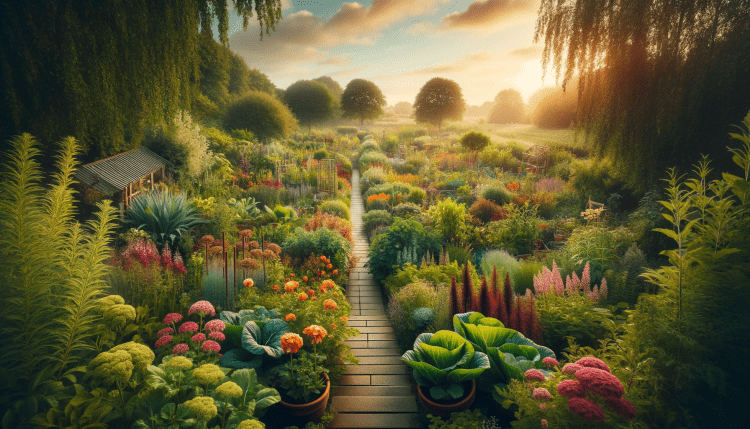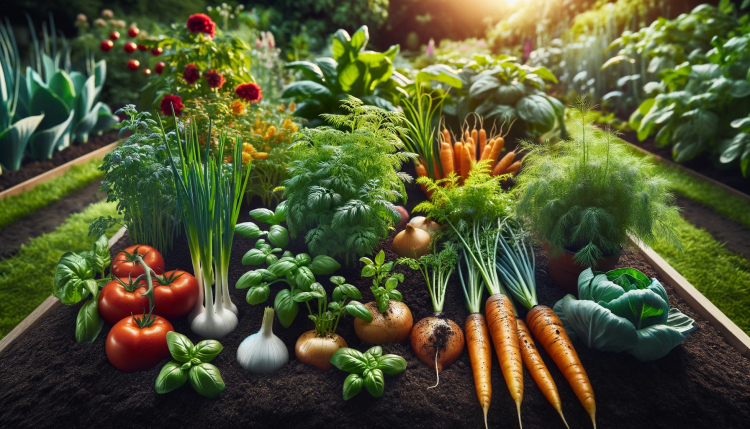
Selecting the right plants for your garden is crucial for both the health of your garden and the success of your gardening endeavors. This guide will explore the importance of thoughtful plant selection, focusing on concepts like companion planting, the benefits of heirloom varieties, and more.
Understanding Your Garden’s Needs
Assessing Your Environment
- Climate and Hardiness Zone: Choose plants suited to your local climate and hardiness zone for the best chances of success.
- Soil Type: Understand your soil type – whether it’s sandy, clay, or loamy – to select plants that will thrive in your garden’s conditions.
Sunlight and Water Requirements
- Light Levels: Match plants with the light levels available in your garden, whether full sun, partial shade, or full shade.
- Watering Needs: Consider the watering requirements of each plant and group together those with similar needs to simplify care.
The Benefits of Companion Planting

What is Companion Planting?
Companion planting involves strategically placing plants near each other to mutually benefit from their natural properties, such as pest control, pollination, or nutrient uptake.
Examples of Effective Companions
- Tomatoes and Basil: Basil repels insects harmful to tomatoes and is believed to improve their flavor.
- Carrots and Onions: The strong scent of onions can deter carrot flies.
Embracing Heirloom Varieties

Understanding Heirloom Plants
Heirloom plants are open-pollinated varieties that have been passed down through generations, often for 50 years or more. They are valued for their unique flavors, colors, and historical significance.
Advantages of Heirlooms
- Genetic Diversity: Heirloom plants offer greater genetic diversity, which can lead to better resilience against disease and changing climate conditions.
- Flavor and Nutrition: Many gardeners find that heirloom varieties offer superior flavors and nutritional profiles compared to mass-produced counterparts.
The Importance of Plant Diversity
Creating a Balanced Ecosystem
- Variety: A diverse range of plants can create a more resilient garden ecosystem, reducing the risks from pests and diseases.
- Attracting Beneficial Insects: A variety of plants can attract beneficial insects, which help with pollination and natural pest control.
Seasonal Considerations
- Succession Planting: Choose plants with different maturing times to ensure a continuous harvest throughout the growing season.
The Role of Native Plants
Benefits of Native Planting
- Adaptation to Local Conditions: Native plants are well adapted to local soil, climate, and wildlife, often requiring less maintenance and resources.
- Supporting Local Wildlife: Native plants provide essential habitats and food sources for local birds, insects, and other wildlife.
Incorporating Native Plants
- Research Local Species: Consult local gardening groups or agricultural extensions to learn about native plants suited to your area.
Selecting Plants for Specific Goals
Ornamental Gardening
- Aesthetic Preferences: Consider the color, texture, and form of plants to create visually pleasing arrangements.
- Long-Lasting Blooms: Choose plants with staggered blooming times for a garden that’s colorful throughout the season.
Edible Gardening
- Nutritional Value and Yield: Select plants that provide the most nutritional benefits and yield for the space they require.
- Herbs and Perennials: Incorporate herbs and perennial vegetables for a sustainable, low-maintenance food source.
Tips for Choosing Healthy Plants

Buying from Reputable Sources
- Quality Nurseries: Purchase plants from reputable nurseries or garden centers known for their healthy, disease-free plants.
Inspecting Plants Before Purchase
- Healthy Roots and Foliage: Check for signs of healthy roots, vibrant foliage, and the absence of pests and diseases.
Choosing Plants is Science and Art
Choosing the right plants for your garden is a blend of art and science. By considering factors like your garden’s environmental conditions, the benefits of companion planting and heirlooms, and your personal gardening goals, you can create a thriving, beautiful, and productive garden. Remember, the best garden is one that reflects your interests and commitments, whether it’s to beauty, biodiversity, or sustenance.




